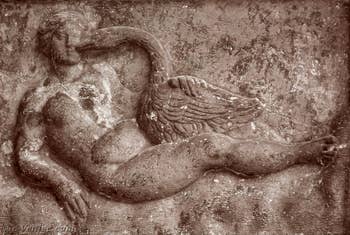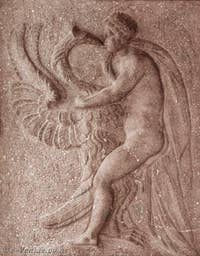History Important dates | Politics | Navy | Love | Wars | Religion | Scuole | Ghetto | Printing
Love Giorgio Baffo | Casini Casins | Cicisbeo
The Casins or Casini, Small Houses of Pleasure

Leda and the Swan Casin means “small house” and Venice had up to 200 of them in the parish of San Marco alone.
It was also the Casini that gave their name to today's casinos.
These "little houses" of ill repute, initially used mainly for carnal pleasures, were later transformed into brothels where gambling also took place, until some casini became exclusively devoted to games of chance, including the famous Pharaoh, which ruined many Venetian nobles.
Private casini thus gave way to public casini, the most famous of which was the famous Ridotto, open throughout the carnival season, where the nobles held the bank while an entire generation ruined themselves, including Antonio Da Ponte and Casanova.
But what interests us here are the romantic casini...
The casin was invented by the nobles, the wealthiest members of society who could afford to have several homes.
The casin consisted of several rooms, often very richly and, above all, very comfortably furnished to accommodate the beautiful ladies. People ate, laughed, played and enjoyed themselves there...
One of the most famous casini was the one where Casanova met the nun M. M.
This casin, located in Murano, belonged to Monsieur de Bernis, then French ambassador to Venice, who would go on to become Cardinal de Bernis.
Casanova described the famous casin so well in his memoirs that it has been found and even the route taken by the amorous nun to reach it by boat has been reconstructed.
Casanova described the famous casin so well in his memoirs that it was possible to find it and even reconstruct the route taken by the nun in love to reach it by boat from her convent.

Leda and the Swan Another famous casin is that of the Procuratessa Venier, wife of the procurator of the same name.
Indeed, although casini were initially the preserve of men for receiving their mistresses, noble women soon had their own and in turn received their lovers there.
Madame could therefore quietly receive her Cicsbeo there, and some even had their hairdresser accompany them, who alternately served as a tout or sometimes as a midwife!
The casin, or rather the bachelor pad of the Procuratessa Venier, still exists. It is located above the sottoportego delle Acque and can be seen when crossing the Ponte dei Bareteri. It is the house on the corner of the rio and the Merceria.
The casin of the Procuratesse Venier consisted of three rooms and a kitchen and one of its distinctive features, unique to casini, was a trapdoor hidden in the tiled floor, which allowed a direct view of the vestibule on the ground floor.
This made it possible to avoid unpleasant surprises...
This is what Jérôme de La Lande said about the casini in 1765 in his book "Voyage en Italie" (Journey to Italy):
“Casins are small apartments around St. Mark's Square, above the cafés and in the procuraties, consisting of two or three rooms.
The master of the casin goes there every evening to dine with the lady he serves ; he receives his guests or special friends there, and they often spend a large part of the night there.
They play games and laugh a lot.
Foreigners are rarely admitted, as they would disturb the gaiety and freedom of these little gatherings.”
Jérôme de La Lande - Voyage en Italie
One can imagine that these casini were not to the liking of the authorities, who found it very difficult to check what went on there and, above all, what was said.
The constant fear of conspiracy led the Serenissima to ask the inquisitors to keep an eye on the casini from 1704 onwards. We have a record of the closure of one of these casini in 1720: “About twenty patricians gathered with their wives and twenty other people.”
Swinging had become all the rage among the nobility in Venice, who invited their wives to share their pleasures in the casini...
One can imagine how much these casini must have delighted the libertine Baffo, who described their scents with relish...
“Having gone to my casino with a woman, I enjoyed myself as much as I could, and first of all I did my business [...] Then I rested a little, and after emptying more than one glass, I resumed my lovemaking with her.”
Giorgio Baffo
Casin for love, casin for gambling, these tastes for lust, gambling and idleness that were widespread among the Venetian nobility of the 18th century were already signs of the decline of the Republic of Venice, which would disappear at the end of the same century after nearly a thousand years of greatness.
Love Giorgio Baffo | Casini Casins | Cicisbeo
History Important dates | Politics | Navy | Love | Wars | Religion | Scuole | Ghetto | Printing
Back to Top of Page

